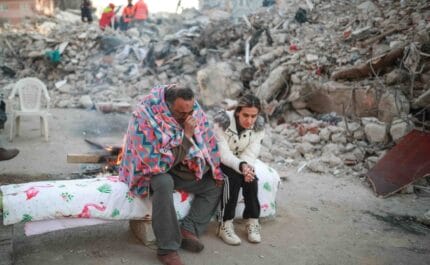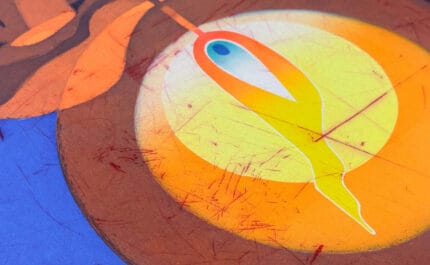Inside Quneitra – the Golan’s shattered ghost town
On 5th June 2011 hundreds of Palestinians crossed into the former Syrian region of the Golan, where they were met by a hail of Israeli bullets. In DG #3 – published in the autumn of that year, just as Syria was beginning to slide into civil war – Michael Hodges (@viewfrompenge) visited the protesters’ starting point in the flattened border town of Quneitra, and reported on what he found: a city-sized memorial where it’s always 1974…
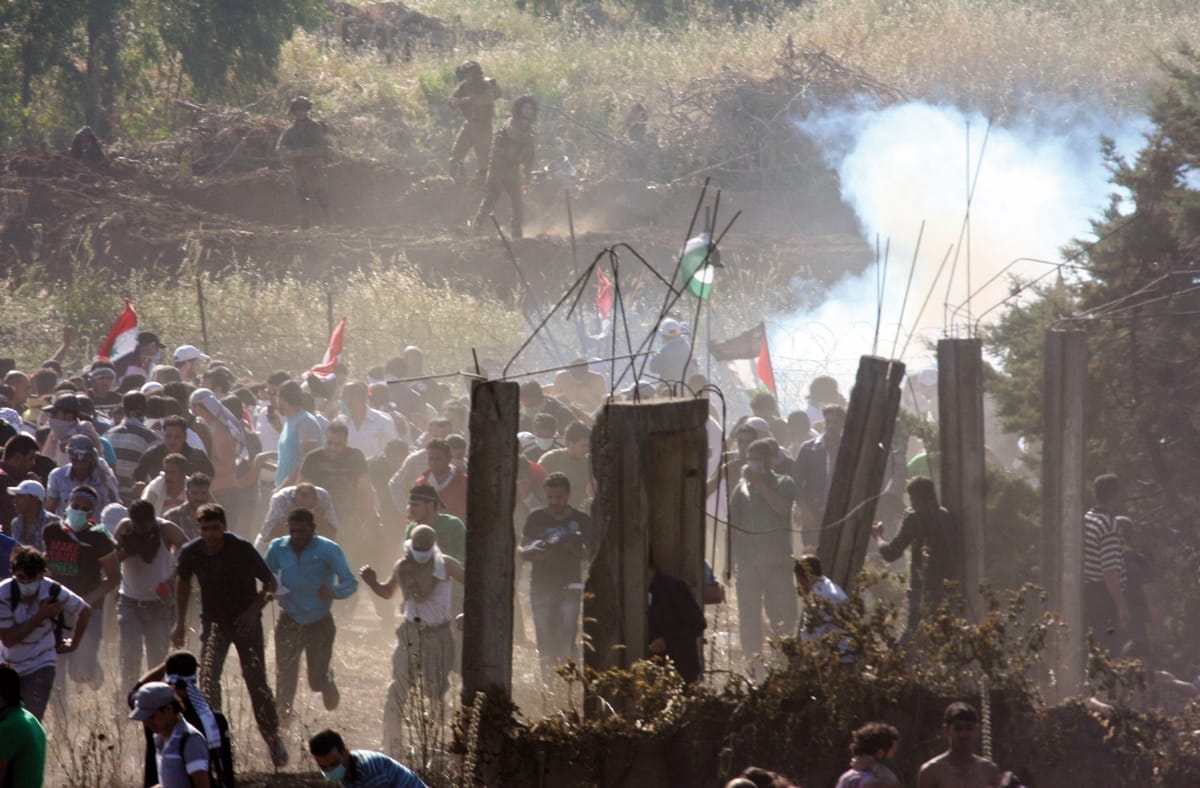
Palestinian and Syrian protesters take cover in Quneitra from teargas fired by Israeli soldiers, 5th June 2011. Photo: Bassem Tellawi / AP / PA Images
5th June 2011 (Taken from: #3)
Presumably the Ba’athist architect didn’t intend the sculpture to be so phallic, but looking through the curtained windows of the minivan there distinctly appeared to be a large penis at the side of the road. We were on the edge of the Golan, halted at a heavily guarded Syrian army checkpoint near the abandoned and ruined city of Quneitra in the demilitarised zone that separates unoccupied Syrian territory from the Israeli lines.
Several soldiers approached the van before one took my passport and – as is often the case in Syria – took it to a room to be smoked over by an official. So I took the opportunity to slip across the road to see the penis. Close up I realised the unlikely sculpture was actually a fist and an arm thrusting out of a boulder, all cast in bronze.
“It represents,” observed a sardonic TV journalist who was travelling in the government van with me, “the might of the Syrian people, ready to smash the Zionist colonisers.” Rather than virility, then, the phallus-cum-fist actually symbolised Syrian impotence, since, 44 years after the arrival of the Israel Defense Forces, who had conquered and occupied the bulk of the region, the Zionist colonisers in question remained – farms, vineyards, settlements and all – very much un-smashed.
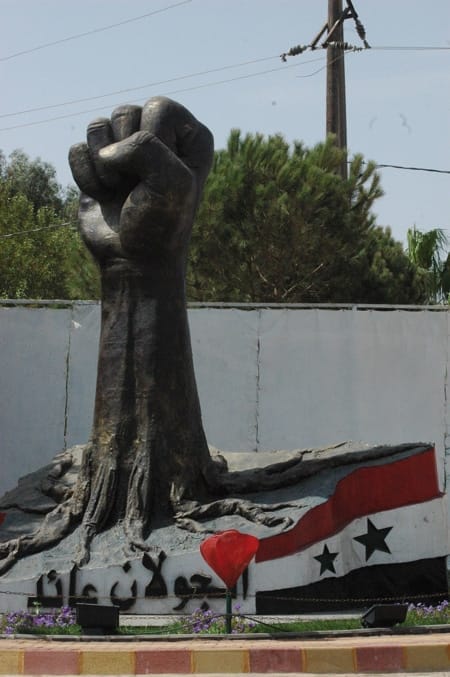
Photo: Richard Conway
The Six-Day War of 1967 was a disastrous defeat for the Arabs and is remembered every 5th June as the Naksa, or “setback”. Jordan lost east Jerusalem and the West Bank, Egypt the Sinai, and its leader, Gamal Abdel Nasser, his reputation as the Arab messiah. Syria lost the Golan, the 1,200 square kilometres of well-watered massif that rise in the north to the 2,184m-high slopes of Mount Hermon, stretch north-east to within sight of Damascus and fall away in the south-west to Lake Tiberias, known more commonly to Europeans as the Sea of Galilee. The 20,000 citizens of Quneitra lost their homes forever.
As almost everywhere in the Levant turns out to be, the Golan, at the halfway point of the Fertile Crescent, is a crossroads. The abandoned capital, Quneitra, takes its name from the root qantara, Arabic for “bridge”, and for millennia it has served as the crossing point for those who travel the eastern Mediterranean littoral from the Nile to the Euphrates and beyond.
Many armies have come in both directions: Pharaohs, Assyrians, Persians, Greeks, Romans, Byzantines, Arabs and, in 1967, Israelis. During the 1973 Yom Kippur War a surprise attack by the Syrians almost recaptured the entire Golan. Following negotiations after that war, the Israelis pulled out of Quneitra in 1974, destroying everything as they left. Although Israel denied the act, the UN condemned the deliberate destruction of the city (Resolution Number 3,740). The Syrians, sensing a rare propaganda victory, did not reoccupy Quneitra, but left it as it was, a macabre testament to the region’s hatreds, a theme park of Middle Eastern war.
The hospital was a skeleton, pock-marked throughout by high-calibre machine-gun fire”
Although there was still snow on the slopes of Mount Hermon overlooking the borders of Syria, Lebanon and Israel, as I contemplated the defiant sculpture winter was loosening its grip on the hills. In a few weeks the Arab Spring would come to Syria and President Bashar al-Assad’s Ba’athist regime would earn international opprobrium for the injury, torture and killing of hundreds of its own citizens. Much of the injury, torture and killing would be at the personal guidance of the president’s younger brother, Maher – or, as the Turkish government would shortly name him, “the thug in chief” – the reviled commander of the elite 4th Brigade of the Syrian army.
The heart of the revolt would be nearby at Daraa on the Jordanian border, where, on 25th March, thousands would attend the funeral of five protesters shot down by the 4th Brigade. Infuriated by the deaths and the national shame of the continuing Israeli occupation of Syrian territory, the crowd would chant, “Maher, you coward! Send your troops to liberate the Golan!”
But if you want to liberate the Golan, don’t send an Assad. The family have lost the region twice on their watch. Bashar’s father, Hafez, was minister of defence during the debacle of 1967 and president during the defeat of 1973 (or October War of Liberation as Syrian history books have it). His oldest son, Basil, an accomplished show jumper, might have been more effective if he had become president, but died in a car crash in 1994. It has been left to Bashar’s wife, Asma al-Assad, born in Acton in west London, to lead the struggle by being photographed with exiles from the Golan. Asma is extremely attractive, but the president who looked down at me from the army checkpoint as my passport was handed back is not naturally photogenic.
Pinch-faced and chinless, Bashar lacks the camp glamour of his dead brother Basil or the podgy malevolence of Maher. He wears a pencil moustache for distinction, which merely gives him a touch of the George Orwells: appropriately enough, perhaps, as Bashar presides over a state in which Newspeak is the language of government. Unarmed civilians, gunned down in the street, are “terrorists’’; the abject situation in the Golan “heroic resistance”.
Driving into the city of Quneitra I entered an unsettling landscape of pancaked garages, groceries, schools and family homes, a ghost city with signs in Arabic and English saying “October the 6th Farm” and “Arab marturs [sic] graveyards”. Little stood above the rubble: a ruined hospital, the shell of a mosque and the Greek Orthodox church where Pope John Paul II prayed in May 2001 that the people of the Middle East might “break down walls of hostility and division and… build together a world of justice and solidarity”.
It was an apposite prayer as the vista around the church was mainly one of broken-down walls. Pines stood sentinel amid the levelled buildings and wrecked cars rusted in meadows, their curved lines betraying their 50-year vintage. The four-storey hospital was a skeleton, pock-marked throughout by high-calibre machine-gun fire.
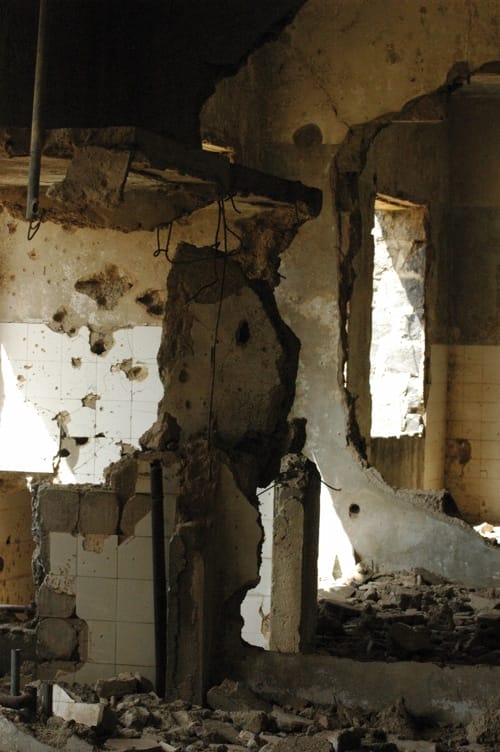
The destruction inside Quneitra Hospital. Photo: Richard Conway
Some rooms had armed guards who looked a little gormless and refused entry, although there seemed no particular reason why any room should be more dangerous or secret than any other. Only the occasional white wall tile hinted at the building’s original purpose, that and a sign above the main entrance that read: “Golan Hospital – it was destroyed and changed into a firing target and training place for Zionists.”
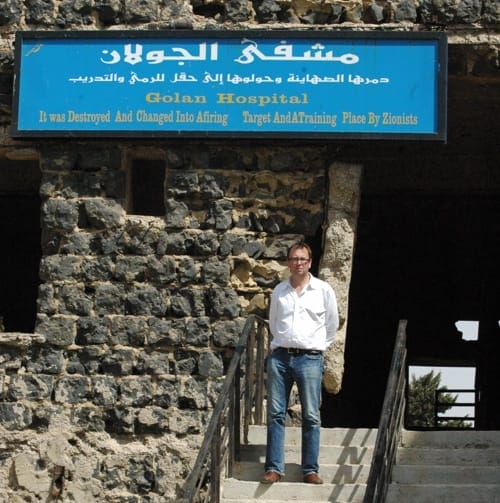
Michael Hodges outside the hospital. Photo: Richard Conway
“Al-Quneitra,” the Syrian government has declared, “will remain a semantron that will chime in the memory of the world reminding it of what the Zionists did to it, and our Arab people in the occupied Golan will remain the symbol of the resistance and struggle.” Whatever a semantron might be, this is not one that chimes in the memory of the world, as most of the world has no idea that Quneitra exists.
The reason for this becomes apparent on a visit to the Quneitra Museum, a complex of one-storey buildings on a hillside on the outskirts of the city. It is a propaganda centre and yet, as this is a high-security zone, there was no one there. This was a paradox that did not appear to trouble the director, Mr Muhammad, who welcomed us on the steps and told me frankly that he would like many more people to come and see his museum. We were led into a garish official conference suite where sweets and trays of tea were produced and Mr Muhammad smiled benevolently from an imitation Louis XIV chair at the head of the room. He explained how the land had been taken from Syria and how hard they had tried to get it back peacefully; indeed Syria was a force for peace and stability in the region.
After half an hour we were invited to ask questions. I raised a hand and began: “The Golan Heights…” Mr Muhammad opened his palms to stop me. “No,” he sighed. “We do not call it the Golan Heights. There is no such name in geography. That is a term used by the Israelis.” The word Heights, it was explained to me, emphasises the Golan’s position above Israel’s northern Galilee region, thus making it an existential threat to the Zionist state and justifying the Israeli occupation.
Displays on the walls of atrocity photographs showed dead and maimed civilians being pulled from the rubble”
I apologised and asked whether there were any plans to get the Golan back. Immediately a woman of mixed Syrian-Scandinavian descent who had joined us took strong offence. “What do you mean get it back? What kind of question is that to ask? What do you expect them to do?” I didn’t expect them to do anything, I just wondered if Mr Muhammad’s employers had any plans – ambitions even – in that direction.
But how could they, when Israeli air power so dominates Syria that they are able to bomb the country’s nuclear facilities at will, as they did in 2007? It seemed both impolite and impolitic to mention this, and as no one else did we moved across the corridor to another room, which was, it became apparent when the lights flickered into life, the epicentre of the Quneitra Museum’s counter-propaganda mission.
There were displays on the walls of atrocity photographs showing dead and maimed civilians being pulled from the rubble of destroyed buildings and worse. Much of the room was taken up by a tabletop papier-mâché relief model of Quneitra and the Golan. The director pointed out the cotton-wool trees and the international borders – borders that stretched down to the shores of the Sea of Galilee before 1967 – marked out with what appeared to be lines of Christmas-tree lights. It was a solemn moment rendered slightly silly by the unspoken knowledge that as long as the Israelis chose or were allowed to remain on the hill that overlooked us, the international borders were as much a fantasy as Father Christmas.
Outside the museum we shook hands with Mr Muhammad and drove for ten minutes to a UN post manned by affable Fijians that looked out over 50 metres of scrub to the first IDF checkpoint. Israeli public gestures owe less to the plastic arts than Syria’s and more to the literary tradition, in particular fiction: no fists here, just a banner hoisted over the checkpoint that reads, “Welcome to Israel.”
Protesters approached the wire under Palestinian flags and Arabs on the other side cheered them on”
We took lunch at the grandly named Nerval Land Resort Hotel. It is built in the rococo Middle Eastern palace style, albeit a small version and is unique in that it is still standing – although it is doing so on the edge of a minefield that begins in the back garden. Inside the Nerval were more imitation Louis XIV chairs, standing by red drapes and marble floors coated with a film of dust. We were served a gargantuan feast of fattoush, chicken quarters baked in herbs with garlic and potatoes, stuffed peppers, stuffed tomatoes, stuffed aubergines, stuffed peppers, kibbeh, hot flat bread still puffed up from the oven and the ubiquitous hummos. The sardonic TV journalist passed a water bottle my way and winked. It was filled with vodka. Later, fired by the alcohol, we went out in the back garden. Beyond, minefield lines of rusting barbed wire gave way to sloping ground that rose to a ridge bristling with IDF satellite dishes and electronic snooping equipment.
Yet despite this technological superiority the Israelis contrived to miss the invasion when it came. Unsurprisingly it was not Maher’s 4th Brigade – which was sent north to burn down bakeries on the Turkish border – that marched on the Zionist colonisers, but exiled Palestinians. On Wednesday 15th May, Nakba Day – which marks the “catastrophe” of the founding of Israel in 1948 – at the edges of Israel’s zone of control, in the Lebanon, the Golan and even Jordan, Palestinians tired of waiting for an end to their exile simply started walking home. A sort of Golan carnival developed in which the protesters approached the wire under Palestinian flags and Arabs on the other side cheered them on.
On the Lebanese border a dozen Palestinians died but in the Golan 200 demonstrators made it to the Israeli-occupied Syrian town of Majdal Shams. One of those Palestinians, 28-year-old Hassan Hijazi, caught a bus from Majdal Shams and made it all the way to what, pre-Nakba, had been the family home in Jaffa. Before his return to Syria he told Israeli TV: “I don’t recognise the state of Israel or its army.” And the soldiers? “One was sitting by my side,” said al-Hijazi. “He looked scared.”
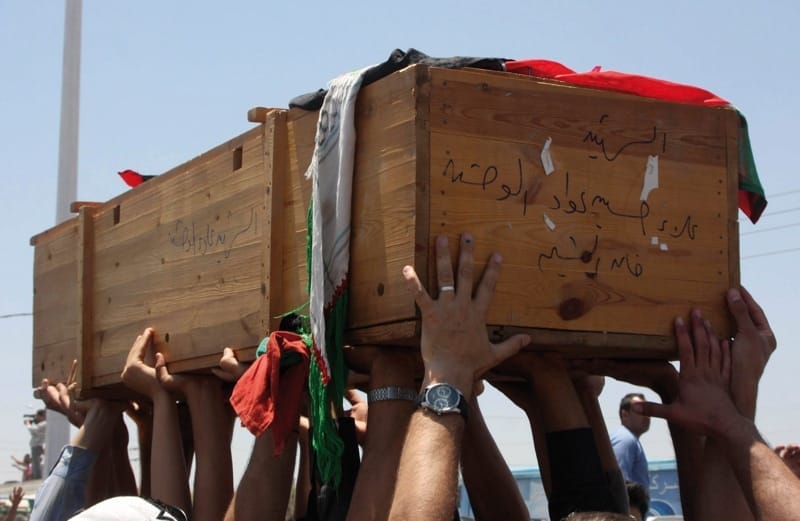
Palestinian mourners carry the coffin of a protester killed on 5th June 2011. Photo: Bassem Tellawi / AP / PA Images
It was always likely that Israelis would have their revenge. On Sunday 5th June, Naksa Day, unarmed Palestinians carrying flags approached the Israeli lines once again. Although an Israeli government spokesman would later suggest that the 20 Palestinians who died had strayed into the minefield that surrounded Quneitra, the actual Israeli response was soon on show on YouTube: footage of IDF troops firing into the approaching crowd. No one went to Jaffa this time because no one crossed the fence. Once again the reputation of the IDF, like that of Maher al-Assad’s 4th Brigade, was upheld, and the Golan returned to its uneasy stand-off – borders closed and fists raised.
Slow Journalism in your inbox, plus infographics, offers and more: sign up for the free DG newsletter. Sign me up
Thanks for signing up.

